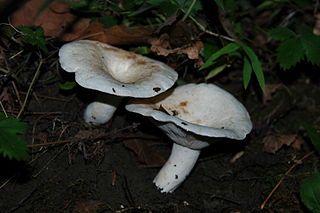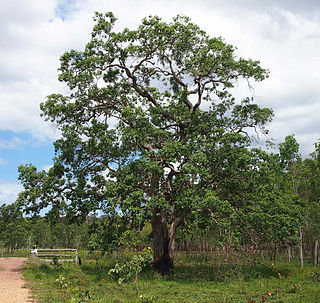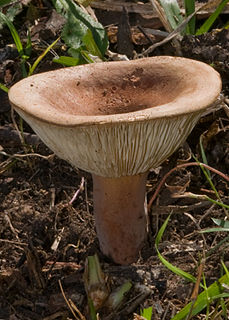
The Russulaceae are a diverse family of fungi in the order Russulales, with roughly 1,900 known species and a worldwide distribution. They comprise the brittlegills and the milk-caps, well-known mushroom-forming fungi that include some edible species. These gilled mushrooms are characterised by the brittle flesh of their fruitbodies.

Lactarius is a genus of mushroom-producing, ectomycorrhizal fungi, containing several edible species. The species of the genus, commonly known as milk-caps, are characterized by the milky fluid ("latex") they exude when cut or damaged. Like the closely related genus Russula, their flesh has a distinctive brittle consistency. It is a large genus with over 500 known species, mainly distributed in the Northern hemisphere. Recently, the genus Lactifluus has been separated from Lactarius based on molecular phylogenetic evidence.

Lophostemon is a genus of 4 species of evergreen tree in the myrtle family Myrtaceae. All four species are native to Australia, with one extending to New Guinea. The genus was first described in 1830 but not widely recognized until the 1980s. All 4 species were previously included in the related genus Tristania.

Lophostemon confertus, is an evergreen tree native to Australia, though it is cultivated in the United States and elsewhere. Common names include brush box, Queensland box, Brisbane box, pink box, box scrub, and vinegartree. Its natural range in Australia is north-east New South Wales and coastal Queensland but it is commonly used as a street tree in Sydney, Melbourne, Perth and other cities in eastern Australia.
Stylidium ensatum is a dicotyledonous plant that belongs to the genus Stylidium that was described as a new species by A.R. Bean in 2000, though the taxon had been noted by Rica Erickson in her discussion of S. muscicola variation in 1958. The specific epithet ensatum is from the Latin ensatus, meaning sword-like, which refers to the shape of the floral throat appendages of this species. It is an erect annual plant that grows from 14 to 22 cm tall. Obovate or orbicular leaves, about 6-17 per plant, are scattered along the stems. The leaves are generally 7–12 mm long, 5.5–12 mm wide, and lack petioles. This species generally has one to three scapes and cymose inflorescences that are 8–16 cm long. Flowers are pink or mauve. S. ensatum is endemic to the area around Darwin in the Northern Territory of Australia. Its habitat has been reported as being a "Melaleuca viridiflora-Lophostemon lactifluus forest with damp peaty soil." It flowers in the southern hemisphere from June to July. S. ensatum is most closely related to S. muscicola. Its conservation status has been assessed as data deficient.

Milk-cap is a common name that refers to mushroom-forming fungi of the genera Lactarius, Lactifluus, and Multifurca, all in the family Russulaceae. The common and eponymous feature of their fruitbodies is the latex ("milk") they exude when cut or bruised. Mushrooms with typical milk-cap characteristics are said to have a lactarioid habit. Some of them are edible.

Lactifluus piperatus, commonly known as the blancaccio, is a semi-edible basidiomycete fungus of the genus Lactifluus. Despite being edible, it is not recommended by some because of its poor taste, though can be used as seasoning when dried. The fruiting body is a creamy-white mushroom which is funnel-shaped when mature, with exceptionally crowded gills. It bleeds a whitish peppery-tasting milk when cut. Widely distributed across Europe and eastern North America, Lactifluus piperatus has been accidentally introduced to Australia. Mycorrhizal, it forms a symbiotic relationship with various species of deciduous tree, including beech, and hazel, and fruiting bodies are found on the forest floor in deciduous woodland.

Lactifluus volemus, formerly known as Lactarius volemus, is a species of fungus in the family Russulaceae. It is widely distributed in the northern hemisphere, in temperate regions of Europe, North America and Asia as well as some subtropical and tropical regions of Central America and Asia. A mycorrhizal fungus, its fruit bodies grow on the ground at the base of various species of trees from summer to autumn, either individually or in groups. It is valued as an edible mushroom, and is sold in markets in Asia. Several other Lactifluus mushrooms resemble L. volemus, such as the closely related edible species L. corrugis, but these can be distinguished by differences in distribution, visible morphology, and microscopic characteristics. L. volemus produces a white spore print and has roughly spherical spores about 7–8 micrometres in diameter.

Trichiocercus sparshalli, the long-tailed bombyx or Sparshall's moth, is a moth of the family Notodontidae. It was first described by John Curtis in 1830 and it is found in Australia.

Panacela lewinae, or Lewin's bag shelter moth, is a moth of the family Eupterotidae. The species was first described by John Lewin in 1805. It is found in Australia from southern Queensland to southern New South Wales.

Lactifluus deceptivus, commonly known as the deceiving milkcap, is a common species of fungus in the family Russulaceae. It is found throughout eastern North America on the ground in coniferous forests near hemlock or deciduous forests near oak, and in oak-dominated forests of Costa Rica. It produces large mushrooms with funnel-shaped caps reaching up to 25 cm (9.8 in) in diameter, on top of hard white stems that may reach 4–10 cm (1.6–3.9 in) long and up to 3 cm (1.2 in) thick. The gills are closely spaced together and yellowish-cream in color. When young, the cap is white in all parts, but the depressed center becomes dull brownish in age and breaks up into scales. The edge of the cap has a roll of cottony tissue that collapses as the cap expands. The surface of the stem—L. deceptivus might be confused include Lactifluus piperatus, L. pseudodeceptivus, L. caeruleitinctus, L. subvellereus, Lactarius arcuatus and Lactarius parvulus.

Lactifluus hygrophoroides is a member of the milk-cap genus Lactifluus in the order Russulales. It was first described scientifically by Miles Joseph Berkeley and Moses Ashley Curtis in 1859 as a species of Lactarius, and was historically known by this name until the systematics of milk-cap species were recently revised. It is a choice edible, although some report its taste to be mild.

Lophostemon suaveolens is a tree species, also known as swamp mahogany, swamp box or swamp turpentine, of the botanical family Myrtaceae.

Lactifluus is one of three genera of mushroom-forming fungi containing species commonly named "milk-caps", the others being Lactarius and Multifurca. It has been separated from Lactarius based on molecular phylogenetic evidence but is very similar to that genus. There are roughly 150 known Lactifluus species, which have a mainly tropical distribution but are also found in the north temperate zone and Australasia. Some of them are edible mushrooms.
Lactifluus edulis is a species of agaric fungus in the family Russulaceae. Described as new to science in 1994, it is found in Burundi.
Lactifluus aureifolius is a species of agaric fungus in the family Russulaceae. It is found in Burundi, where it grows in miombo woodland dominated by Brachystegia utilis. The fungus was described in 1996 as a species of Lactarius.

Lactifluus clarkeae is an Australasian milk-cap mushroom. It was described as Lactarius species in 1927 by Australian naturalist John Burton Cleland and was transferred to the genus Lactifluus in 2012.
Cryptophasa epadelpha is a moth in the family Xyloryctidae. It was described by Edward Meyrick in 1890. It is found in Australia, where it has been recorded from New South Wales and Queensland.
Lophostemon grandiflorus is a member of the family Myrtaceae endemic to Western Australia, the Northern Territory and Queensland.













